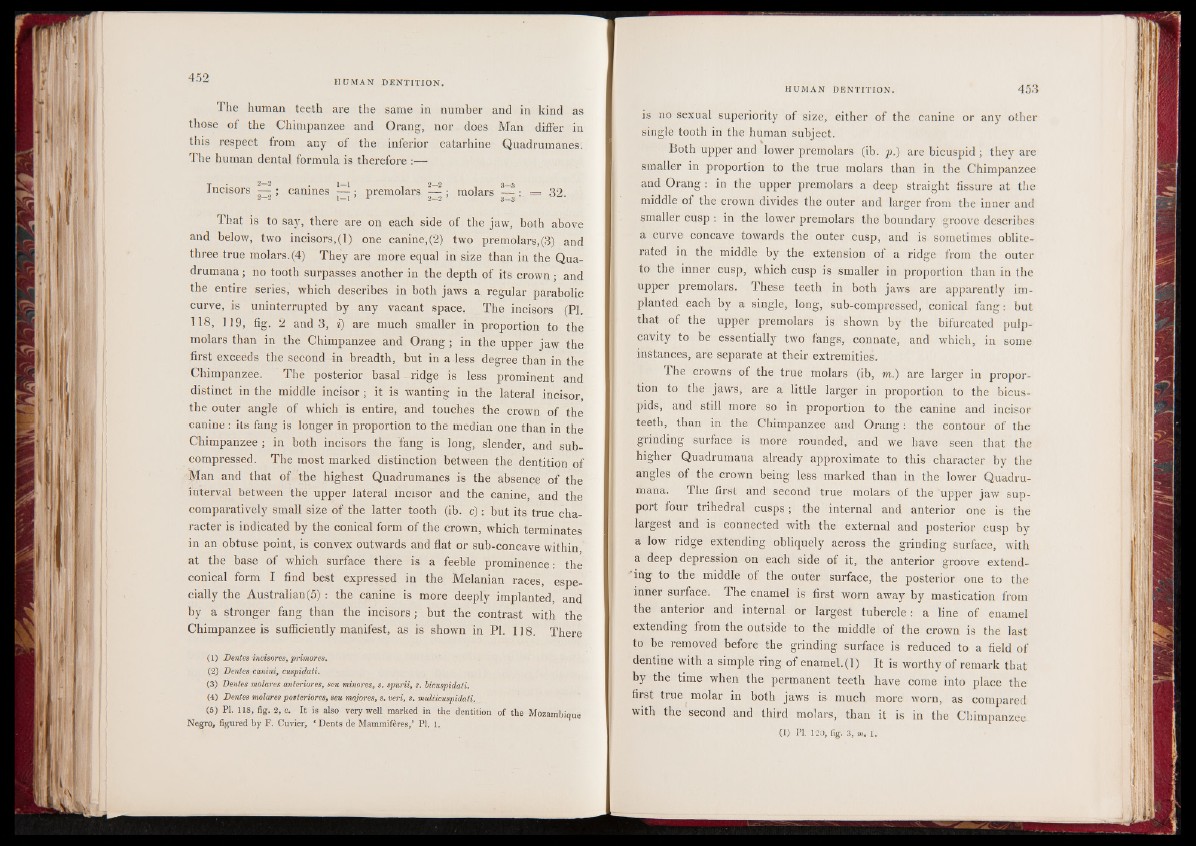
The human teeth are the same in number and in kind as
those of the Chimpanzee and Orang, nor does Man differ in
this respect from any of the inferior catarhine Quadrumanes:
The human dental formula is therefore
tIn ci* sors —2—2 #; ca|n i|n es — 2; —2 premolars — ; molars — = 32.
That is to say, there are on each side of the jaw, both above
and below, two incisors,(1) one canine,(2) two premolars,(3) and
three true molars. (4) They are more equal in size than in the Qua-
drumana ; no tooth surpasses another in the depth of its crown ; and
the entire series, which describes in both jaws a regular parabolic
curve, is uninterrupted by any vacant space. The incisors (PI.
118, 119, fig. 2 and 3, i) are much smaller in proportion to the
molars than in the Chimpanzee and Orang ; in the upper jaw the
first exceeds the second in breadth, but in a less degree than in the
Chimpanzee. The posterior basal ridge is less prominent and
distinct in the middle incisor ; it is wanting in the lateral incisor
the outer angle of which is entire, and touches the crowm of the
canine : its fang is longer in proportion to the median one than in the
Chimpanzee ; in both incisors the fang is long, slender, and subcompressed.
The most marked distinction between the dentition of
Man and that of the highest Quadrumanes is the absence of the
interval between the upper lateral incisor and the canine, and the
comparatively small size of the latter tooth (ib. c) : but its true character
is indicated by the conical form of the crown, which terminates
in an obtuse point, is convex outwards and fiat or sub-concave within
at the base of which surface there is a feeble prominence : the
conical form I find best expressed in the Melanian races, especially
the Australian (5) : the canine is more deeply implanted, and
by a stronger fang than the incisors ; but the contrast with the
Chimpanzee is sufficiently manifest, as is shown in PI. 1 ] 8. There 1
(1) Dentes incisores, primores.
(2) Dentes canini, cuspidati.
(3) Dentes molares anteriores, sen minores, $. spurii, s. bicuspidati.
(4) Dentes molares posterior es, seu majores, s. veri, s. multicuspidati.
(5) PI. 118, fig. 2, t. It is also very well marked in the dentition of the Mozambique
Negro, figured by F. Cuvier, ‘Dents de Mammifères,’ PI. 1.
is no Sexual superiority of size, either of the canine or any other
single tooth in the human subject.
Both upper and lower premolars (ib. p.) are bicuspid; they are
smaller in proportion to the true molars than in the Chimpanzee
and Orang : in the upper premolars a deep straight fissure at the
middle of the crown divides the outer and larger from the inner and
smaller cusp : in the lower premolars the boundary groove describes
a curve concave towards the outer cusp, and is sometimes obliterated
in the middle by the extension of a ridge from the outer
to the inner cusp, which cusp is smaller in proportion than in the
upper premolars. These teeth in both jaws are apparently implanted
each by a single, long, sub-compressed, conical fang: but
that of the upper premolars is shown by the bifurcated pulp-
cavity to be essentially two fangs, connate, and which, in some
instances, are separate at their extremities.
The crowns of the true molars (ib, m.) are larger in proportion
to the jaws, are a little larger in proportion to the bicuspids,
and still more so in proportion to the canine and incisor
teeth, than in the Chimpanzee and Orang: the contour of the
grinding surface is more rounded, and we have seen that the
higher Quadrumana already approximate to this character by the
angles of the crown being less marked than in the lower Quadru-
mana. The first and second true molars of the upper jaw support
four trihedral cusps; the internal and anterior one is the
largest and is connected with the external and posterior cusp by
a low ridge extending obliquely across the grinding surface, with
a deep depression on each side of it, the anterior groove extend-
'ing to the middle of the outer surface, the posterior one to the
inner surface. The enamel is first worn away by mastication from
the anterior and internal or largest tubercle: a line of enamel
extending from the outside to the middle of the crown is the last
to be removed before the grinding surface is reduced to a field of
dentine with a simple ring of enamel. (1) It is worthy of remark that
by the time when the permanent teeth have come into place the
first true molar in both jaws is much more worn, as compared
with the second and third molars, than it is in the Chimpanzee
(I) PI. 120, fig. 3, m , 1.